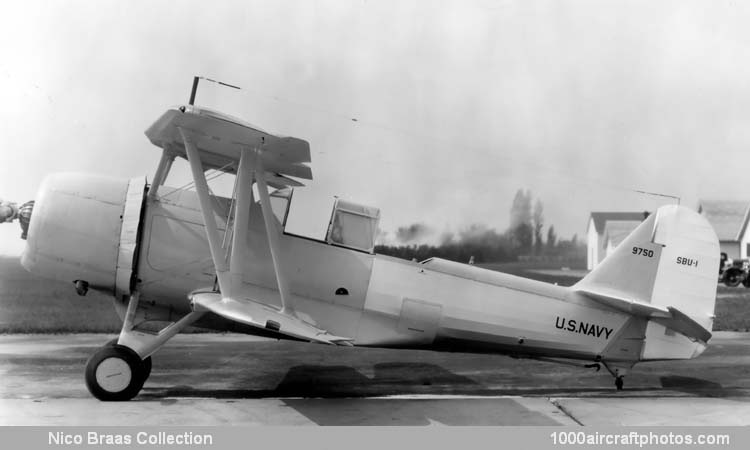The Chance Vought Division of United Aircraft and Transport Corporation, at East Hartford, Connecticut, which had produced the XF2U-1 prototype in competition with the Curtiss F8C, was one of seven manufacturers submitting proposals for Design 113, and on June 30, 1932, received a contract for a prototype designated XF3U-1 with BuNo. 9222.
First flown in May 1933, the XF3U-1 was a biplane of conventional metal construction with fabric covering and powered by the fully-cowled small-diameter 700 hp Pratt & Whitney R-1535-64 fourteen-cylinder two-row air-cooled radial engine.
In November 1933 the Navy asked Vought to modify the XF3U-1 into a prototype scout-bomber designated XSBU-1, and indicated a likely requirement for at least 27 production models. Modifications included greater internal fuel capacity, stronger and larger wings, provision for a 500 lb (227 kg) bomb under the fuselage and other smaller items.
The XSBU-1 was, in fact, a new airframe with the XF3U-1's original engine and equipment, but when delivered to the Navy for trials in June 1934 it retained the same serial number. A year later, the original XF3U-1 airframe was resurrected as a test bed for Pratt & Whitney engines and received the new BuNo. 9746.
A production order for 84 SBU-1s (BuNos. 9750 to 9833) was placed with Vought in January 1935. They were similar to the prototype scout-bomber version, with R-1535-80 engines and an armament of one 0.30 in (7.62 mm) fixed forward-firing and one 0.30 in (7.62 mm) Browning machine gun flexibly mounted in rear cockpit, plus the external bomb.
Deliveries began on November 20, 1935, with Scouting Squadron VS-3B the first to be equipped, followed by VS-2B and VS-1B. A second batch of 40 of the Vought scout-bombers were built as SBU-2s (BuNos. 0802 to 0841) with R-1535-98 engines and minor changes. Late in 1937, 24 of these SBU-2s were delivered, new, to the Naval Reserves, serving until 1941, also in 1937, another fourteen aircraft where delivered to the Argentine Navy.
During night carrier landing practice at NAS San Diego on August 25, 1938, Lieutenant (jg) Robert B. Moore of VS-42 experienced an engine failure just after take off in BuNo. 9750, and the aircraft ditched. The SBU-1 stayed afloat for thirty seconds, during which the crew escaped, Moore sustaining minor injuries, Seaman 1st Class Harold Stang staying unharmed."
Span: 33 ft 3 in (10.13 m)
Length: 27 ft 10 in (8.48 m)
Height: 11 ft 11 in (3.63 m)
Wing area: 327 sq.ft (30.38 sq.m)
Weight empty: 3,645 lb (1,653 kg)
Loaded weight: 5,520 lb (2,504 kg)
Max speed: 205 mph (330 kmh) at 8,900 ft (2,713 m)
Cruise speed: 122 mph (196 kmh)
Climb: 1,180 ft (360 m)/min
Service ceiling: 23,700 ft (7,224 m)
Range: 548 mls (882 km)
